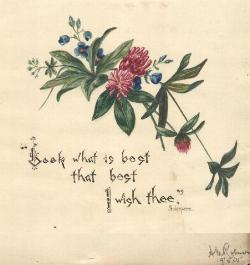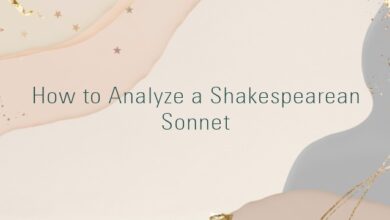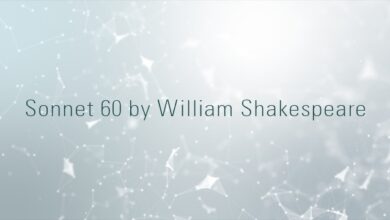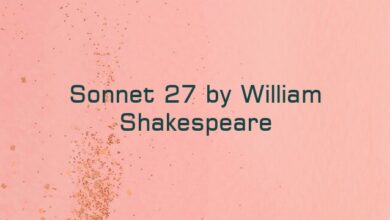
O truant Muse what shall be thy amends
For thy neglect of truth in beauty dyed?
Both truth and beauty on my love depends;
So dost thou too, and therein dignified.
Make answer Muse: wilt thou not haply say,
‘Truth needs no colour, with his colour fixed;
Beauty no pencil, beauty’s truth to lay;
But best is best, if never intermixed’?
Because he needs no praise, wilt thou be dumb?
Excuse not silence so, for’t lies in thee
To make him much outlive a gilded tomb
And to be praised of ages yet to be.
Then do thy office, Muse; I teach thee how
To make him seem, long hence, as he shows now.
�The poet continues with his cheeky castigation of the Muse. Perhaps by throwing all the blame on her he can show that he is guiltless, and in fact that he is better than her, for best is best if never intermixed, therefore he should not need to mix his own inspiration with that provided by the Muse. Indeed, by the end of the poem he is offering to teach her how it should be done, and the youth no doubt is expected to be an amused bystander of all this. To the reader there is perhaps an awareness of contradiction or, at the very least, forgetfulness, for not so long ago the youth was being accused of betrayal, or having (or not having) virtue which did not match the outward show, or being a festering lily. But all that is now forgotten and the poet is happy to present him once more as the epitome of truth and beauty.
The 1609 Quarto Version
OH truant Muſe what ſhalbe thy amends,
For thy neglect of truth in beauty di’d?
Both truth and beauty on my loue depends:
So doſt thou too,and therein dignifi’d:
Make anſwere Muſe,wilt thou not haply ſaie,
Truth needs no collour with his collour fixt,
Beautie no penſell,beauties truth to lay:
But beſt is beſt,if neuer intermixt.
Becauſe he needs no praiſe,wilt thou be dumb?
Excuſe not ſilence ſo,for’t lies in thee,
To make him much out-liue a gilded tombe:
And to be praiſd of ages yet to be.
Then do thy office Muſe,I teach thee how,
To make him ſeeme long hence,as he ſhowes now.
Commentary
1. O truant Muse what shall be thy amendstruant Muse – the original meaning of ‘truant’ is rogue, knave, vagabond, a sturdy beggar, an idle rascal (OED.1 & 2.a). Here it could be either a noun or an adjective, and its meaning is probably defined by neglect in the following line. The Muse has neglected her duty (of praising the youth) as a truant neglects his duty to society, or by missing school. There is also a secondary meaning of ‘being unfaithful’, as in:
‘Tis double wrong, to truant with your bed’ CE.III.2.17.
where ‘truant’ is used as a verb, in the sense of ‘to play truant with’, ‘to abscond from’.
what shall be thy amends = what recompense will you offer, what penance will you do?2. For thy neglect of truth in beauty dyed?

But from thine eyes my knowledge I derive,
And, constant stars, in them I read such art
As truth and beauty shall together thrive,
If from thyself to store thou wouldst convert;
O, how much more doth beauty beauteous seem
By that sweet ornament which truth doth give!
No doubt Keat’s famous closing lines in ‘Ode to a Grecian Urn’ owe something to Shakespeare’s Sonnets:
Beauty is truth, truth beauty. That is all
Ye know on earth and all ye need to know.
3. Both truth and beauty on my love depends;depends is a plural verb. Both truth and beauty derive their being from the youth who is the archetype and ideal form of them both. The idea is neo-Platonic in origin, although here slightly distorted in that the Platonists claimed that truth and beauty were the ideal forms from which all exemplars derived. Here the exemplar (the youth) itself is given the status of the ideal, and truth and beauty are deemed to derive from it.
my love = the beloved youth; my love for him.4. So dost thou too, and therein dignified.So dost thou too – the Muse is being addressed. She also depends for her existence on the youth, who is the source of all inspiration.
and therein dignified = and you achieve dignity through this dependence, you are dignified as a result.5. Make answer Muse: wilt thou not haply say,haply = perhaps. Also with a suggestion of ‘happily, aptly’. The poet provides the answer which he believes the Muse might give.6. ‘Truth needs no colour, with his colour fixed;colour = painting, description, colouring. The idea behind these two lines, 6-7, seems to spring as much from the use of cosmetics (and Shakespeare’s dislike of it) as from the art of painting. A fair face needs no cosmetics, it already has its own fixed colour and appearance. In the same way truth needs no additional colouring, since it has its own.
his colour = its own colour; or, the beloved’s colour and appearance.
fixed = made permanent, as one fixes a colour in painting by varnishing it (putting fixer on it).7. Beauty no pencil, beauty’s truth to lay;pencil = small paint brush, (the modern lead pencil had not been invented);
to lay = to paint, to depict by laying paint on a surface, or one colour upon another; to define. I.e. beauty needs no brushes to paint itself or its own truth and being, since it is itself its own best exemplar, and the youth, being beauty personified, himself shows what truth and beauty are.8. But best is best, if never intermixed’?
best is best – this is obviously tautological but is close in sense to many proverbs and semi-proverbs. SB lists ‘Truth is truth’, ‘Better is better’ and ‘The best may amend’.
The idea is that what is perfect would become imperfect if tainted or blended with baser, unnecessary substances. It needs no more than itself to justify itself, and it needs no advertisement, as good wine needs no bush (AYL.V.Epi.4.).
But perhaps more signifiantly there is probably a covert reference to holy communion and the communion bread, as in Sonnet 125.
And take thou my oblation, poor but free,
Which is not mixed with seconds, knows no art, 125 10-11.
Communion wafers had to be made out of the best flour, without any admixture or intermixing with inferior grades. The youth is likened to the living god as manifested in the communion service, or the Mass, in which the host is consecrated.
See the Introductory Notes for further discussion of the religious themes of the Sonnets. 9. Because he needs no praise, wilt thou be dumb?The poet now queries the Muse’s argument (having supplied it himself in the first place). The whole thing might be seen as an elaborate ploy for proving that the Muse is superfluous. At the end of the poem she has to be taught how to sing the youth’s praises.10. Excuse not silence so, for’t lies in theeExcuse not silence so = do not provide such lame excuses for your silence. He is still addressing the Muse.
for’t lies in thee = for it is within your power (as the inspirer of poetry).11. To make him much outlive a gilded tomb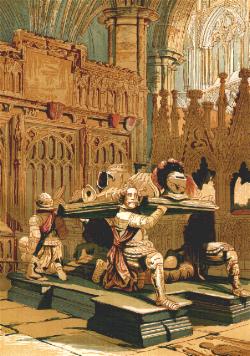
And thou in this shalt find thy monument,
When tyrants’ crests and tombs of brass are spent. 107.
Perhaps Sonnet 81 comes nearest in sentiment to these two lines , 11-12:
Your monument shall be my gentle verse,
Which eyes not yet created shall o’er-read,
And tongues to be your being shall rehearse
When all the breathers of this world are dead;12. And to be praised of ages yet to be.
ages yet to be = future generations. Sonnet 17 refers to ‘The age to come‘ , Sonnet 104 to ‘thou age unbred’ , and Sonnet 81 to ‘tongues to be‘ (see above), but there are surprisingly few references to future ages in the sonnets, despite the overwhelming impression created that the youth, through the force of poetry, will be immortalised and admired for ever by future generations.13. Then do thy office, Muse; I teach thee howDo thy office, Muse = perform the task which is allotted to you, Muse. A somewhat peremptory command to give to a being who was supposed to be a goddess.
I teach thee how – a further indignity is heaped on the Muse. Having played truant in line 1 she now has to be taught the lessons she has missed.14. To make him seem, long hence, as he shows now.
long hence = in a time far distant from this.
as he shows now – as he appears at present. Superficially this is a straightforward statement that poetry immortalises its subject, but it has the disconcerting effect of casting doubt on the reality of the image. The use of the words seem and shows introduces the possibility that the youth’s truth and beauty are no more than a magic shadow show, that they will disappear as soon as the artificial light is removed, as in Plato’s cave, or perhaps as in the shows put on in the theatres of the South Bank, which lasted no longer than a brief afternoon.

